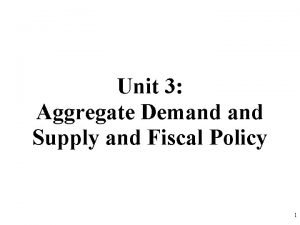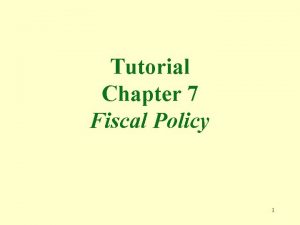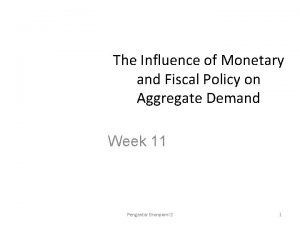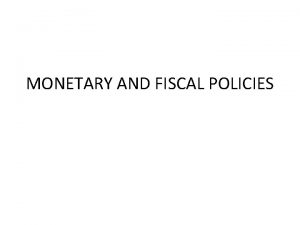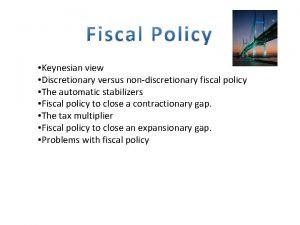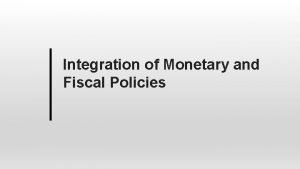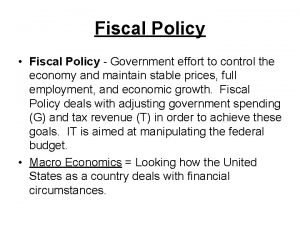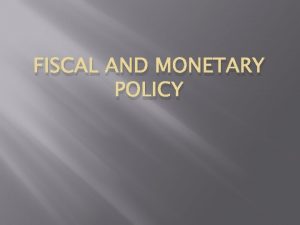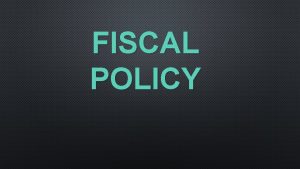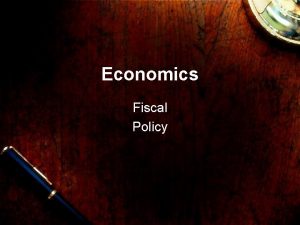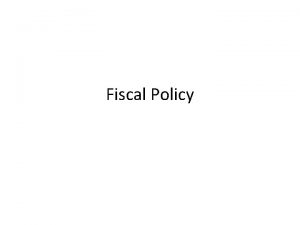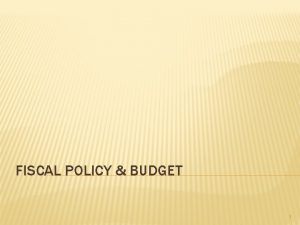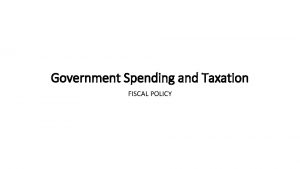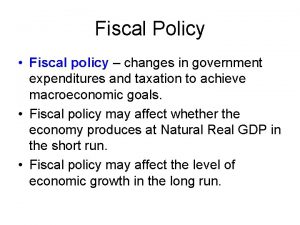The Government Fiscal Policy HW Complete the Chapter













- Slides: 13

The Government & Fiscal Policy HW: Complete the Chapter 15 Assessment (p. 410 -411) #1 -14; answers only – we will go over the answers tomorrow!

Fiscal Policy Fiscal policy is the use of government spending and revenue collection (taxes) to influence the economy. Just like the Federal Reserve has “tools” to influence the economy, the government does too. The Federal Reserve sets monetary policy. The US Government sets fiscal policy. The federal government spends about $250 million every HOUR, roughly $6 billion each DAY and about $2. 2 trillion a YEAR. All this cash flow can impact aggregate demand supply and have an impact on our economy.

The Federal Budget Fiscal policy involves making decisions about how much the government should spend and how much they should tax and is used to achieve three things: Economic growth Full Employment Price Stability Decision about spending and taxation happen during the creation of the federal budget each year. The federal budget is a document that indicates how much the government expects to receive and authorizes the amount of money the government can spend each year. Just like families have a household budget, so does the government. The federal budget is proposed by the President and appropriated by Congress for the next Fiscal Year (Oct. Sept).

Fiscal Policy and the Economy The government utilizes two types of fiscal policy – expansionary and contractionary. Expansionary policies aim to increase output (GDP) by increasing Government spending and lowering taxes. Contractionary policies aim to decrease output (GDP) by decreasing Government Spending and increasing taxes.

Expansionary Policy Intended to encourage economic growth and production Increase Government Spending (G) – when G increases, it triggers a chain of events that raises output and creates jobs. When G increases, aggregate demand will increase which will cause an increase in prices. The higher prices will encourage suppliers to make more goods, which will create more output and the need for more employees. If the government lowers taxes, C will increase. An increase in C will mean and increase in demand…. Expansionary policy fixes problems with unemployment and recession.

Contractionary Policy Intended to slow economic growth in certain phases of the business cycle If G decreases, aggregate demand will decrease which tends to lower prices and lowers inflation. If the government raises taxes, this will decrease C, which will decrease demand…. Contractionary policy fixes problems related to inflation.

Limits of Fiscal Policy Difficulty changing spending levels Can’t predict the future Delayed results – takes time to implement changes Politics Getting all levels of government board

Different Theories on Economics Throughout history, there has been debate about how a government should spend money and tax the people. These debates have been referred to as economic theories. Classical Economists Keynesian Economists Supply-Side Economists

Classical Economists Prominent Economists – Adam Smith, David Ricardo, and Davis Malthus Core belief – Lassiez-faire policies; economies are self-regulating in the long-run and free markets will always get back to equilibrium eventually The government shouldn’t intervene, just let things in the economy play out and let competition drive it.

Keynesian Economists Prominent Economists – John Maynard Keynes The Great Depression challenged all former beliefs about economics because things didn’t regulate… they just kept getting worse. Banks went out of business, unemployment was at 25%, and people were barely getting by. Wrote a book called The General Theory of Employment, Interest and Money that dispelled the Classical view of the long-run and provided the government with some tools for the “short-run”… what they could do now to fix problems. Keynes believed that during a recession or depression, consumers and businesses demand less – which causes GDP and output to go down. If the government could intervene and spend money, it encourage production and employment. When people got back to work, they would start consuming again, and the economy would turn around. This mind-set is known a “demand-side” economics – involves changing demand to help the economy. Keynes argued that governments could influence demand by changing their spending habits and changing taxes (fiscal policy). Said that a change in spending or taxes could have an impact of a multiple that is greater than the initial spending or tax. This is known as the multiplier effect.

Supply-Side Economists Prominent Economists – Arthur Laffer Promoted a supply-side approach to fiscal policy. Supplysiders believe that taxes have strong negative influences on output and as such, the focus should be on increasing aggregate supply not demand. Created the Laffer Curve that illustrates the relationship between the tax rate and tax revenue that the government collects. Laffer believed that high taxes do not mean more revenue if the tax causes spending/investment to decrease. Laffer said that if the government cut taxes, businesses would hire more people, total employment would increase and the government could collect even more taxes at the lower rate.

Deficit v. Debt Every fiscal year, the federal government begins with a “balanced budget” on paper. This is the idea that the same amount of money is going in and out of the US Treasury. In reality, the federal budget is almost never balanced and that there is always a surplus or deficit. Surplus happens when the revenues collected (taxes) exceed expenditures. Deficit happens when the revenues collected are less than the expenditures. Print/create Borrow more money (creates inflation) more money Commonly borrows money by selling bonds (T-bills, notes, bonds; can be short-term or long-term) Sometimes borrows from other nations

The National Debt The problem with borrowing money is that it creates a national debt (money owed to bondholders). For every year that the budget operates in a deficit the national debt will grow. The more bonds sold, the higher the debt. If you have a bond in your name, the government owes you money. Deficit and debt are not the same thing. Deficit is the money borrowed to cover the expenditures in one fiscal year. Debt is the accrual of government borrowing up to that time minus any borrowing that has been repaid. Check out our national debt at www. usdebtclock. org We’ve been running at a deficit (to create jobs and fund programs) and accruing more debt since 2001. The last time we had a budget surplus was back in the 1990 s. As more Baby Boomers retire, outnumbering the labor force, balancing the budget will be incredibly difficult.
 Galloping inflation
Galloping inflation Example fiscal policy
Example fiscal policy Tax multiplier formula
Tax multiplier formula Components of fiscal policy
Components of fiscal policy Crowding out effect of fiscal policy
Crowding out effect of fiscal policy Unit 5 lesson 2 fiscal and monetary policy
Unit 5 lesson 2 fiscal and monetary policy What is liquidity ratio in banking
What is liquidity ratio in banking Non-discretionary fiscal policy
Non-discretionary fiscal policy Instruments of fiscal policy
Instruments of fiscal policy Econ crowding out
Econ crowding out Fiscal demand side policy
Fiscal demand side policy Fiscal policy to control inflation
Fiscal policy to control inflation Types of fiscal policy
Types of fiscal policy Instruments of fiscal policy
Instruments of fiscal policy

